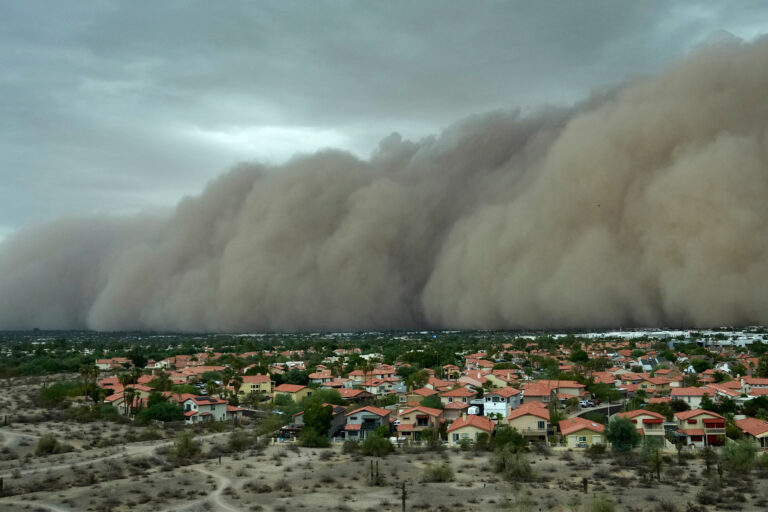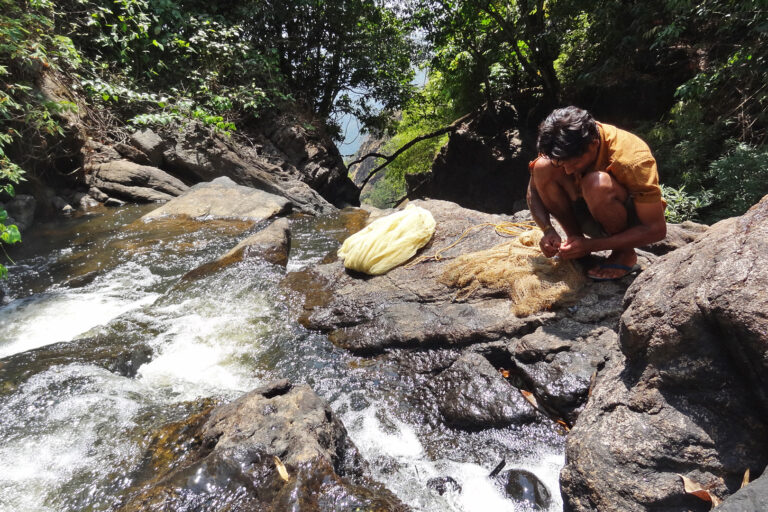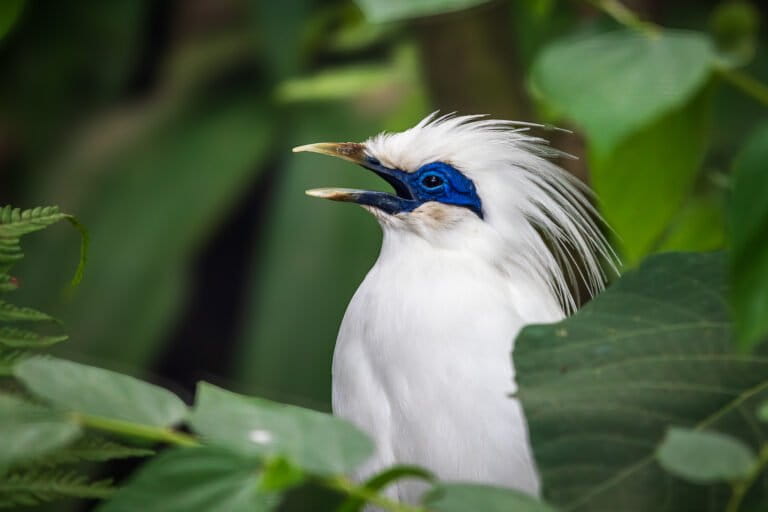- Perhaps fewer than 360 North Atlantic right whales are alive today, according to researchers’ estimates.
- Scientists blame the declining population on the twin tolls exacted by ship strikes and entanglement in fishing gear.
- “Ropeless” fishing gear that minimizes the number of vertical lines in the water that ensnare right whales has emerged as a potential “home run” solution to the entanglement crisis.
- But fishers, industry groups and even ardent proponents of ropeless systems say that it’s not yet a viable replacement for traditional fishing gear in every situation.
The report came in from naturalists aboard a whale-watching boat: A 4-year-old whale calf was entangled in fishing rope. He appeared thin, and lesions mottled his body. A few days later, on Oct. 19, 2020, the aerial survey team was finally able to take off in their plane. From high above in their Cessna Skymaster, they scanned the waters below for the calf, taking advantage of a fog-free autumn day when the winds off the Cape Cod coast had tapered to a breeze.
The youngster proved elusive that day and hasn’t been seen since. But the relatively clear weather allowed the spotters from the Center for Coastal Studies in Provincetown, Massachusetts, to catch a glimpse of another right whale in distress. This one was an 11-year-old male named Cottontail, and he was dragging “hundreds of feet of rope” behind him. They relayed their observations to their teammates on shore, and soon, the center’s Marine Animal Entanglement Response (MAER) team was at sea, headed in Cottontail’s direction to try and cut him free.
Cottontail’s predicament is not unusual. Fishing gear around the globe takes an “incidental” toll on all manner of sea life that it’s not intended to catch, from sharks to turtles to seals, sea lions and other marine mammals. But North Atlantic right whales like Cottontail and the missing calf seem to be especially susceptible to getting bound up. Studies suggest more than 80% of them get entangled at least once in their lives. And the severity of the consequences for right whales has intensified in the past decade, threatening the survival of a species that could be down to fewer than 360 individuals, according to a research group called the North Atlantic Right Whale Consortium.
North Atlantic right whale (Eubalaena glacialis) numbers have been dipping ever lower each year for the past decade, and scientists declared a particularly stark hemorrhage in the population that began four years ago to be an “unusual mortality event.” Since 2017, 50 whales have died or been so severely injured that scientists believe they were not apt to survive. That loss of more than 10% of the estimated population in 2017 was mostly the result of entanglements or collisions with ships.

To avert the trauma from encounters with fishing gear, a recent push to bring “ropeless” gear into widespread use has gained steam. The goal is to remove the vertical lines that connect buoys at the water’s surface with ocean-bottom traps for fish, lobsters and crabs, and the movement has touched off a flurry of innovation.
Oceana, an environmental group, figures that something like 1 million fishing lines striate the water column off the eastern coast of Canada and the U.S. Right whales can grow to 16 meters (52 feet) and more than 63 metric tons, and these ropes throw down a gauntlet in front of them as they hunt for the copepods that are their primary source of food. These tiny, shrimp-like zooplankton shoal in some of the world’s most lucrative fishing grounds, and climate change has shifted the ranges of copepods and animals that fishers target, such as lobsters, making that overlap even more pronounced in some places.
Meanwhile, many fishers, many of whom have ties to the livelihood that run generations deep, say they feel unfairly blamed for the right whale’s demise. A few are collaborating with developers to try out ropeless gear in the challenging conditions of the North Atlantic. Still, they balk at the idea of a wholesale overhaul to their way of life that has changed little for centuries. They say solutions must be tailored to the challenging conditions they face on different fishing grounds, and the gear must not endanger the safety of their crews. They also note that even the most fervent supporters of ropeless gear concede “it’s not quite ready for primetime,” as Sean Brillant, senior conservation biologist with the Canadian Wildlife Federation, put it to Mongabay.
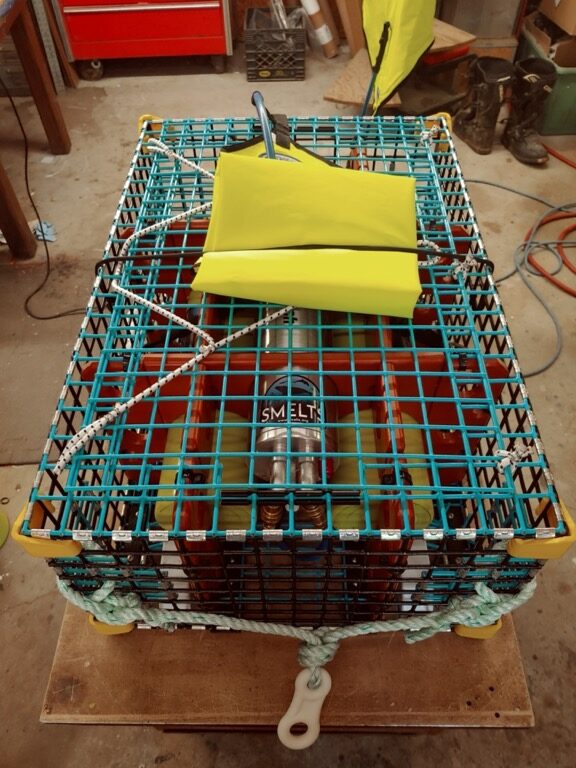
That hasn’t kept the scientists and whale conservationists tracking the right whale’s decline from believing the adoption of ropeless gear could avert impending disaster.
“While there’s rope, there’s entanglement risk, and that’s what we need to get away from,” Michael Moore, a veterinarian and whale biologist at the Woods Hole Oceanographic Institution, told Mongabay.
“I’m more optimistic this time than ever before that this is actually going to be something that’s worthwhile and have a lasting effect,” Moore said of ropeless gear. Previous attempts to change fishing gear or reduce the amount of rope in the water have yielded little benefit for right whales, he said, but ropeless gear could be “a home run.”
There’s no denying that the right whale’s situation is dire.
“Literally, we, legally and biologically, cannot afford to kill even one right whale per year,” said Scott Landry, director of the MAER program. Under the Marine Mammal Protection Act in the U.S., the National Ocean and Atmospheric Administration (NOAA) has set the number of human-caused deaths the right whale population can withstand at less than one individual per year.
To meet that high — some might say impossible — standard, the whale conservation community has rallied around ropeless gear as a consensus solution. It’s one they hope will both keep the North Atlantic right whale from sinking into oblivion and allow the region’s fisheries to continue operating.
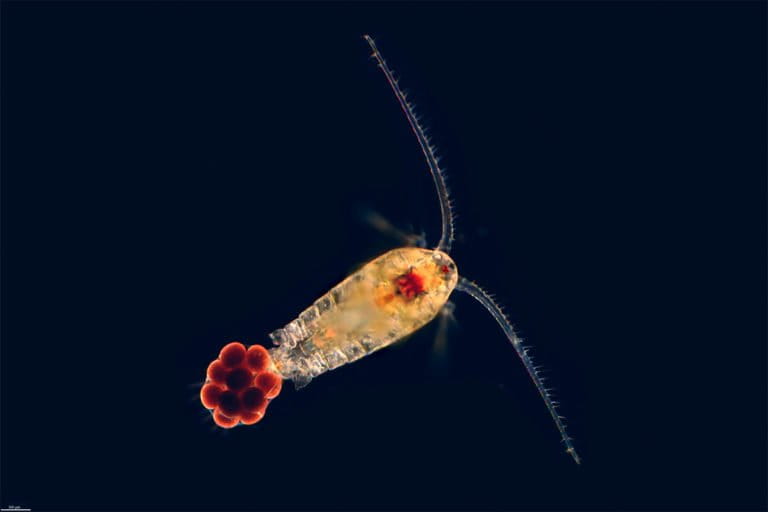
Fishing without ropes
The idea of fishing without ropes strikes some fishers as something of an impossibility.
“Most fishermen … won’t even entertain a ropeless conversation,” said Adam Kenney, a lobster fisher from Nova Scotia who has tested out new ropeless gear designs.
To many fishers, changes to an age-old practice that extends back centuries seem radical and even dangerous.
“Saying that you want to find a way of going fishing without rope or with less rope is a bit akin to saying, ‘Look, I’m going to allow you to use your car, but I won’t give you the benefit of the technology of the wheel,’” Landry said.
Richard Riels, who has developed a ropeless system for catching lobster, said it will involve a massive shift in the approach to fishing.
“All around the world, we’ve taken a string, dangled it down there and pulled something up to eat,” said Riels, founder and director of the NGO Smelts based in the U.S. state of Washington. Now, he added, they’re being told “you can’t do that.”

For trap fishers like Kenney who go after lobsters, crabs, and bottom-dwelling fish, the vertical ropes connecting the trap to a buoy floating at the surface serve two critical functions. First, these “pot warps” allow fishers to haul up traps that (they hope) are full of their catch. Second, the buoys serve as signposts so other fishers won’t crowd the same spot, so fishing boats dragging nets or trawls through the area don’t ruin their gear, and so authorities can keep tabs on the industry. But these vital links between the ocean’s surface and its depths also present the most troublesome threat to right whales and other cetaceans.
In the past few years, a growing cadre of gear companies and NGOs have begun to work on systems aimed at minimizing or even eliminating the miles of vertical ropes in the water column. The systems typically work by letting fishers recover their gear remotely using an acoustic signal. Retrieving equipment from the deep in this way is something oceanographers, industry and the military have done for decades, according to Moore.
Several designs are currently in trial phases. In one example, which uses a phone or similar handheld device from the deck of a boat, fishers can find and return to their traps. When it’s time to check their haul, the acoustic signal sent from the handheld device activates the release of a coiled buoy line stored inside the trap.
In the Smelts system that Riels designed, a canister of compressed air triggered by the signal inflates a float and sends the trap shooting toward the surface.
At the moment, however, Kenney and other fishers who spoke with Mongabay say that the designs aren’t far enough along to fully replace traditional fishing methods.
“We’re still in grassroots, in my opinion,” he said.
In his native Nova Scotia, nearly a thousand fishers hold lobstering licenses, and their gear is typically packed tightly together in prime lobstering waters. And every day, they must battle some of “the highest and strongest tides in the world,” Kenney said.
“It’s almost like a developer will say, ‘OK, it works in Jonesport, Maine, or it works in California for the Dungeness crab. [That] doesn’t mean it’s going to work in the Caspian Sea or off of Nova Scotia,” he added. “They need to understand that environmental conditions play a huge role in making these systems work.”
Kenney said one developer from the U.S. got in touch with him but didn’t know anything about Nova Scotia’s tides, currents or weather. He wasn’t even aware of when the lobster season started. “But they thought they had it figured out.”
At the same time, Kenney said he feels the burden of solving the entanglement problem has been placed squarely on the fishers, as officials threaten to shut down fisheries worth hundreds of millions of dollars a year to communities in Canada and the U.S.

Brillant, the Canadian conservation biologist, said he understands that argument. He pointed out that these fisheries have long anchored local economies.
“They’re like, ‘Well, what’s going on?’” Brillant said. “‘Everything’s been fine until now. Why don’t we just continue because I’m fishing just like my pappy and my grandparents?’”
To be sure, until the late 1990s, entanglements didn’t pose the problem that they do today.
“The right whale population has increased from the ’80s, right?” Kenney said. “We may be responsible for some deaths, but we’re certainly not responsible for them all.”
Indeed, studies reveal the fishing industry is not solely to blame for the right whale’s precarious position. Ship strikes also exact a hefty toll on the species and have for decades, despite ongoing attempts to get ships to slow down around whales or avoid their favorite ranges entirely.
But the slim rise in the absolute number of right whales since the 1980s that Kenney alluded to is more an indication of the whales’ rock-bottom numbers at that time than of a true recovery. Back then, whaling had nearly erased the species from the cold waters of the North Atlantic. Though current numbers are higher than that nadir, they’re also lower than the apex reached a decade ago and declining fast. Plus, whales today face a noisier, warmer ocean realm that’s more crowded and more confusing than the one they swam in just three or four decades ago.
The ‘right’ whales — to kill
Once numbering in the thousands off eastern North America, the North Atlantic right whale was a ready target for whalers in the centuries since Europeans first stepped ashore. They often swim slowly close to the coast, making an approach possible in oared vessels from shore. After death, their carcasses typically float rather than sink like those of most whales. That made it easier for whalers to extract the valuable oils from the blubber and to harvest the baleen plates, used much as we do plastic today to make things like corsets at the time. All that added up to E. glacialis being tagged as the “right” whale for whalers to kill.
And kill they did, nearly wiping them out by the time an international ban on hunting them commenced in 1935. As recently as 1992, fewer than 300 right whales remained. But around that time, their numbers began creeping back up at a rate of 1 to 2% a year to a peak of perhaps 500 animals by 2010. It looked as if the species was inching, albeit slowly, toward recovery.

In the southern Atlantic, however, numbers of southern right whales (E. australis) have been rising at a much stronger clip of 7 to 8% a year, and current estimates peg the total at as many as 15,000 individuals. That disparity in population growth led scientists to believe that differences in the threats the two closely related species face are likely to blame.
North Atlantic right whales typically hang out in some of the world’s busiest shipping lanes, where huge vessels shuttle goods across the Atlantic. Container ships hundreds of meters long plow through right whale territory at speeds of 25 kilometers per hour (15.5 miles per hour). Authorities in Canada and the U.S. have called for vessels to slow down in places where right whales have been seen, and they train onboard spotters to locate whales at the surface. But the problem hasn’t gone away. Few vessels comply with speed rules, and even trained observers have a hard time picking out a jet-black right whale lolling at the surface or slowly siphoning up copepods just below.
Many right whales bear the scars of brutal encounters with massive cargo ships and smaller vessels alike. Scientists figure ship strikes cause roughly half of recorded North Atlantic right whale deaths. In February, the carcass of an infant calf found on a beach in Florida had gashes on his head and back, likely from a boat propeller. The unnamed whale became the first recorded death of 2021.
But by the end of the 20th century, another worrying trend had materialized: North Atlantic right whales were turning up tangled in fishing lines, often with gruesome results. Moore remembers whale number 2030, which he calls his entanglement “poster child.”
Reports in May 1999 told of a whale enmeshed in a gill net and fishing line swimming far off the coast of Massachusetts’ Cape Cod. The 13.5-meter (44-foot) carcass floating on the water’s surface near New Jersey five months later told a story of almost unimaginable suffering. A rope stretched taut had sliced into the whale’s back through thick layers of blubber and skin, all the way down to the muscle. As the animal swam, the line slid toward its tail, essentially flaying it while it lived. The rope left a gash that was 1.4 meters (4.5 feet) at its widest and laid bare both of the animal’s shoulder blades. In a photograph, the whale looks like the victim of a botched decapitation.
“As a veterinarian, I looked at it,” Moore said. He remembers thinking, “‘Holy shit. How could that possibly be?’”
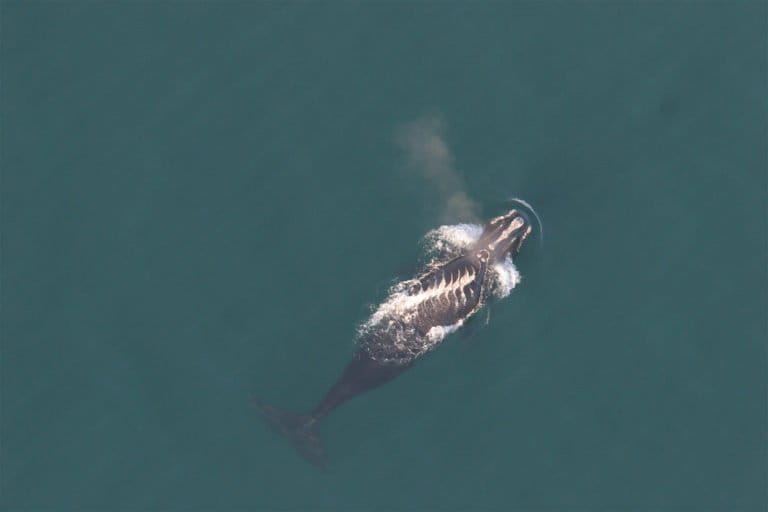
‘Just in misery’
Moore said the general public’s silence about the extreme suffering that entanglements induce is somewhat perplexing, given the furor that whaling elicited before most countries agreed to a commercial whaling moratorium in 1982.
After graduating from veterinary school in the early 1980s, Moore worked as an observer on an Icelandic whaling ship as part of research by the International Whaling Commission. He said he remembers noting that a harpoon with an exploding grenade killed a fin whale (Balaenoptera physalus), another titan of the oceans that grows even larger than a right whale, in about two minutes. Today, the handful of countries that still kill whales in much the same way stir up rancorous disdain from environmentalists, animal rights advocates and the public at large.
“Fast forward to 2020, and the average time to death for a lethally entangled right whale is six months,” Moore said. “It’s not right. It’s not right.”
The 4-year-old calf that the Center for Coastal Studies aerial team had originally been searching for in October 2020 had rope embedded in his head. His mother, a whale named Dragon, was last seen in February 2020 with a line wiring her rostrum and lower jaw together, which probably kept her from eating. Both animals are thought to have died from their injuries.
A network of entanglement response teams in the U.S. and Canada, including MAER, are poised to offer relief when the weather and the whales cooperate. But it’s a complex, dangerous task. In 2017, an experienced crew member was killed in the Gulf of St. Lawrence during a disentanglement attempt.
After dragging gear through the water for weeks or months at a time, whales are often in no mood for help, Landry said.
“We’re getting ahold of a wild animal that’s at the worst moment of their life. They’re in chronic pain probably,” he said, “in many cases, starving, nauseous, extremely ill. And then along comes a boat, and it’s just making their day that much worse.”
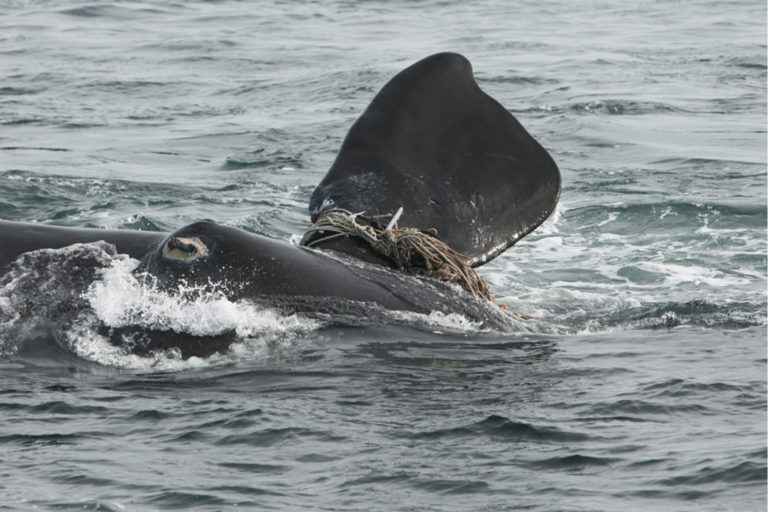
Cottontail’s case crystallizes the challenges that whale rescue teams face. When the MAER team found him towing rope in October 2020, the lines had worked their way around his head and into his mouth like the bit of a horse’s bridle. They were able to remove around 30 meters (100 feet) of rope. But he swam off before they could do more.
“The sense I get is that the animals are just in misery and are extremely unwilling to have our help,” Landry said, drawing on his decades of frontline experience.
In addition to inflicting grievous injuries that can lead to infections or keep whales from feeding, hauling around heavy rope and fishing gear also saps whales’ energy, causing them to lose weight. In a cruel twist, Moore said the emaciated bodies of entangled whales often sink when they die, unlike their ancestors, whose buoyancy made them a prime target for whalers. Losing a carcass to the depths prevents scientists from figuring out what happened to these whales. The deaths become yet another “cryptic mortality” statistic, leaving researchers to guess at their ultimate fate.
Research published in the journal Conservation Science and Practice in February showed that scientists are recording only about a third of all right whale deaths attributable to humans.
What doesn’t kill a whale…
As more and more whales began to turn up either towing fishing gear in the early 2000s, or bearing grisly scars — souvenirs from their run-ins with booming fisheries for lobster and snow crab — research on entanglements likewise intensified. Around this time, scientists were also tracking that slight rise in the population.
Then, after 2011, the right whale population’s growth stalled and began a slide that continues to this day. Initially, it mystified biologists. Deaths mounted, but alone, they didn’t seem to tell the whole story. Studies would soon show that even if entanglement, already affecting most North Atlantic right whales, didn’t kill a whale outright, the lingering effects hamper the species’ recovery.

Today, with fewer than 360 whales left, the loss of a single animal from the population is a blow — again, one that scientists worry the population cannot absorb if it’s going to recover. In the four years between 2017 and 2020, the 22 newborn calves weren’t enough to replace the 32 whales known to have died in that time span.
As a species, right whales are slow to add new individuals to the rolls under the best of circumstances. Most females are at least 10 years when they have their first calves. Pregnancy lasts 12 months, and scientists estimate that a female could have a baby every three years or so under normal circumstances. Dragon had carried three calves to term, including the 4-year-old that the aerial spotters had been looking for when they found a bound-up Cottontail. Losing her and other proven mothers is undoubtedly dragging the population down.
Now, though, research by Moore and his colleagues to quantify the drain on a whale’s energy from entanglement has led scientists to determine that those costs may be stretching that three-year interval between births to six to 10 years.

A 2021 study by Moore and his colleagues reveals another insidious effect of entanglement. Publishing online in the journal Current Biology, the team used a technique known as aerial photogrammetry to assess the size and body condition of North Atlantic right whales from photographs taken from airplanes and drones since 2000. The team found that right whales born in 1980 grew to be about a meter (3.3 feet) longer than will a right whale born today.
Their analysis also teased apart the expected effects of entanglements on individuals. Whales that have been entangled — again, that’s about four of every five right whales — are apt to be about 5% shorter than whales that remain unentangled. The same goes for whales that were nursing while their mothers were entangled.
The overall contraction of whale lengths could portend trouble for the species in the future, the authors write. Shorter whales may have fewer reserves to weather food shortages, or to bear calves.
Such evidence indicates that entanglements may help explain a decade’s worth of declining numbers in the North Atlantic right whale population. It’s added up to a pending — or perhaps more accurately, an in-process — catastrophe for the species. But to paraphrase fisher Adam Kenney, why has the clash between whales and gear become such a problem now, when entanglements in gear were all but unheard of as recently as the 1990s? Part of the answer to that question may lie in a set of forces that are shaping not just the habitat of copepods, lobsters and right whales, but the future for us all.
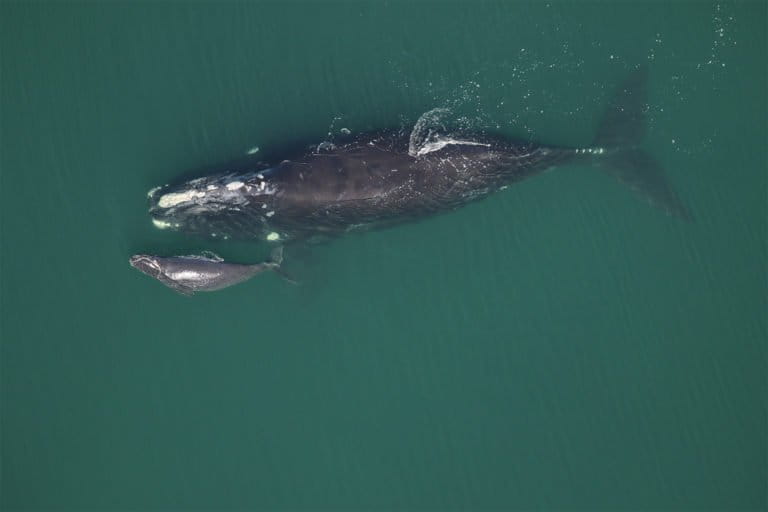
Changing ocean, changing gear
Over the past two decades, temperatures have shot up in the Gulf of Maine, a body of water stretching from Cape Cod in the U.S. to Nova Scotia in Canada that encompasses prime feeding grounds for the North Atlantic right whale. A 2015 study in the journal Science found that climate change warmed these waters through 2013 more quickly than 99% of the world’s oceans.
That heat spike has driven copepods further north, all the way into the Gulf of St. Lawrence. As whales have followed the swarms of zooplankton, they’ve run smack into a thrumming snow crab fishery. Moore explained that crab traps — and the ropes they’re attached to — are heavier than those in other fisheries and thus pose a greater danger of deadly entanglements. And ship strikes have also gone up as whales have moved more frequently into the artery connecting North America’s Great Lakes and the Atlantic Ocean. Moore also suspects that crab-fishing vessels, which are typically larger than lobstering boats, may be colliding with whales more often.
A study in Conservation Biology demonstrated that, as technological advances have increased the strength of fishing rope since the 1990s, the consequences of entanglement for whales have gotten more severe.
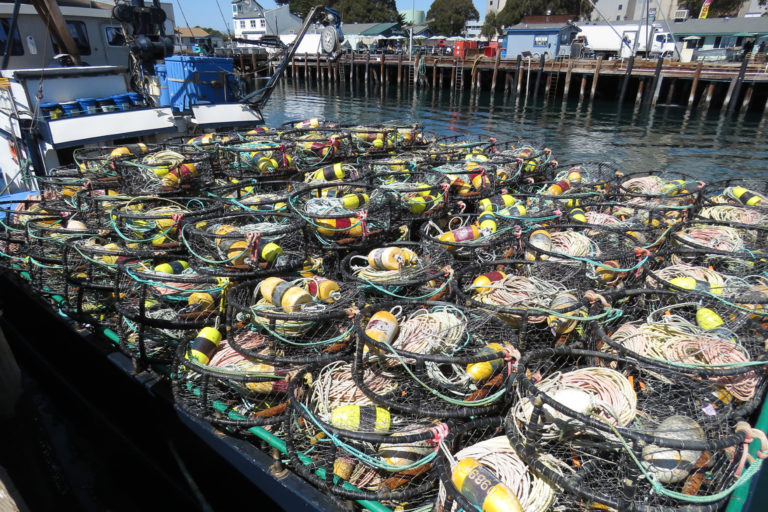
One potential remedy that U.S. agencies like NOAA have been keen to explore is the incorporation of weaker ropes into trap gear. These “weak links” are designed to break under a certain amount of force. The Massachusetts Division of Marine Fisheries has even taken to handing out prototype ropes with lower breaking strengths to fishers on Cape Cod.
Other strategies include mandating the use of sinking lines that connect traps to each other closer to the ocean floor rather than higher in the water column, or daisy-chaining more traps together in a single trawl to minimize the number of vertical warps stretching to buoys on the surface, such as those announced in August by NOAA. These new restrictions also call for using weak rope.
But such attempts to change the problematic fishing lines, rather than removing them altogether, are based on a “false premise” that they would make the entanglement problem go away, Moore said.
“I think the biggest risk to the ropeless concept is that it’ll be forgotten in the rush to weak rope,” he added.
Landry echoed those concerns.
“Rope is rope,” he said. “No matter what color it is, no matter how stiff or how smooth or whatever property, it still can catch whales.”
Weaker rope could also exacerbate the hazards of an already perilous occupation.
“Rope under tension is an extremely dangerous situation,” Landry said, which is a point voiced by several of the fishers who spoke with Mongabay.
What’s more, convincing fishers to embrace a flawed remedy may have serious repercussions in the future, Moore said.
“The fisherman will invest another whole bunch of energy and money in that solution,” he said. “When it comes up short, the level of frustration is going to be even greater than it’s already at now.”
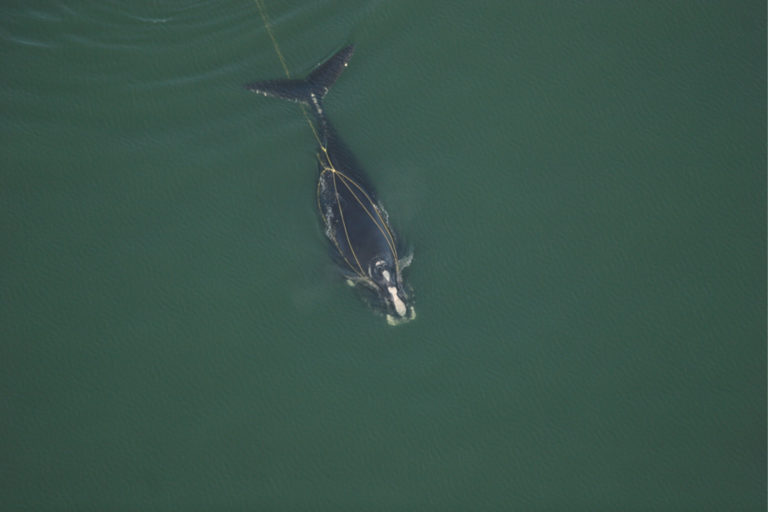
‘A battle of icons’
Just how aggressive the transition to ropeless gear will be depends on a wide set of factors.
Richard Riels of Smelts said the fishers he’s working with are starting to get on board with ropeless systems. He said they’re excited about catching their first “acoustic” or “whale-safe” lobsters.
But there is still trepidation about how well the systems will work in different situations.
Kenney said his testing found that ropeless systems worked about 80% of the time in the shoals, where the water depth was about 10 fathoms (18 meters or 59 feet) and the gear was sheltered from Nova Scotia’s notoriously high tides.
“The problem is, right whales don’t typically swim or go into or feed in a 10-fathom depth of water,” he said. His tests also took place during the summer of 2020. How those traps would fare during the harsher weather of Nova Scotia’s winter lobster season is another matter.
“There’s a long way to go,” Kenney added.
Trials are also currently underway in Canada’s spring snow crab fishery. In 2021, 20 fishers are testing out 50 ropeless traps in places with right whales. To reduce entanglements, U.S. and Canadian authorities have used periodic fishery closures to protect right whales seen swimming through specific areas. But shutting down fishing comes at a cost, dealing an economic blow to fishers and their communities.
Those potential consequences have led to a groundswell of interest among fishers in acquiring ropeless gear to use in places that would otherwise be closed to them, said Robert Haché, director-general of the Acadian Crabbers Association in New Brunswick, Canada.
“[F]ishers here understand that the future of their access to productive fishing grounds will be contingent to efficient whale safety measures such as ropeless gear,” Haché said in an email.
But right now, he said, the practicality of the gear is “very limited.”
“Closed areas are the only potentially viable situation where ropeless could be a solution,” Haché said. NOAA’s recently announced restrictions reduce the areas available to Maine’s lobster fishing industry, along with mandated changes to fishing ropes, in an effort to protect right whales.
Haché said the fishers testing ropeless gear are zeroing in on how easily they can locate traps, both their own and others’, on the bottom of the ocean.
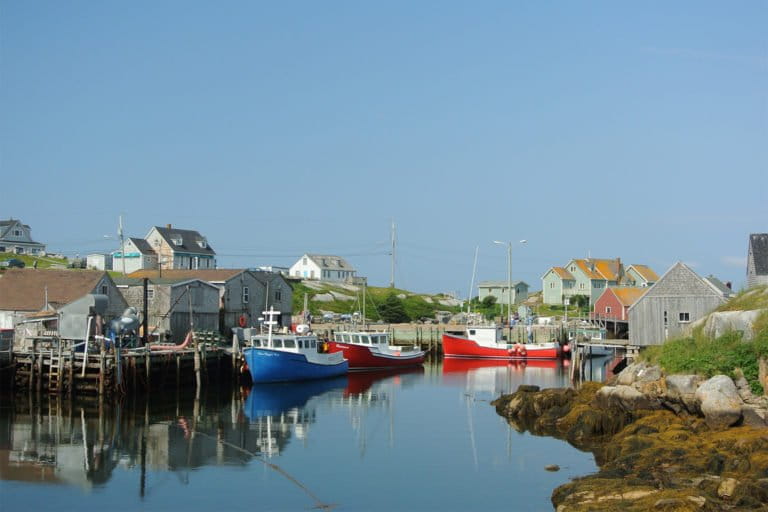
Massachusetts-based EdgeTech created its Trap Tracker application to work on iOS and Android phones and tablets. The app shows the locations of a fisher’s gear and other EdgeTech traps, and fishers can use it to retrieve their traps via Bluetooth. In effect, it’s a virtual replacement for the role that buoys have played in fisheries for centuries — but only if other fishers are also using the EdgeTech system.
“If somebody is using Desert Star, which is one of the other commercially available systems, we wouldn’t see them, and they wouldn’t see us as it stands today, even if we’re right next to each other,” said Rob Morris, a product line sales engineer with EdgeTech.
To address that problem, Morris said, EdgeTech is working on a higher-level, shared database that will incorporate gear positions from other systems. That way, fishers will be aware of the presence of others’ traps and trawls, regardless of which company’s ropeless system they’re working with.
Right now, cross-system visibility isn’t yet a reality. Still, Morris said he’s frustrated when he hears from fishers or reads in the media that ropeless gear isn’t ready yet or that traps need more testing.
“Give me a purchase order, and I’ll sell you some,” he said. “I like to say that we’ve checked every box. There’s not one thing that was required that we haven’t done, except maybe reduce the cost.”
Morris said the price of a unit that can be attached to a single trap or a trawl of a bunch linked together is currently around $4,000. But as fishers buy more systems and production increases, the price will come down. (For comparison, a traditional trap setup including a rope and buoy costs around $100.)
Cost concerns raise the broader point about who should pay for the transition in gear, because everyone involved acknowledges that it will be expensive. Kenney said he expected ropeless-gear costs to be “exponentially higher” than costs for the traditional systems fishers now use.
The snow crab fishery in Canada has received government money to test gear, Haché said. NGOs like Smelts and the International Fund for Animal Welfare have funding from various donors to develop and purchase ropeless gear. But whether that financing will continue to bring more fishers into the ropeless fold or where it might come from in the future is currently unclear.
Moore noted that much of the emphasis until now has been on the fishing industry and the authorities who regulate the fisheries. Less involved, he pointed out, are those of us who buy seafood or rely on the goods that arrive on massive container ships.
“We haven’t mobilized the consumers adequately at all,” Moore said.

In a forthcoming book, We Are All Whalers: The Plight of Whales and Our Responsibility, Moore writes that our choices about the food and other products we buy can make a difference in what happens to whales.
The extension of that argument is that society as a whole could — and should — provide more support for fishers to move to ropeless gear.
“I don’t believe that the fishermen need to shoulder the whole expense because it’s really a societal problem,” Richard Riels said. “We drive the market. We want lobsters in the tanks in a supermarket. And, you know, unfortunately, that dooms the whales.”
Moore acknowledged the challenges of finding a viable path to ropeless gear won’t be easy, and he’s sympathetic to their plight.
“Basically, it’s a battle of the icons, between the lobster fishery and crab fishery and the iconic great whale,” Moore said, “and I honestly believe that we can sustain both if we’re prepared to invest in the subsidies that are necessary to make it happen.”
Kenney, whose family has fished the waters off Nova Scotia for generations, said that fishers don’t want to kill whales.
“The sea provides for us, so we don’t want to jeopardize natural tendencies in the ocean,” he said. “A whale may not seem like it matters in the lobster fishery, but every species plays an important role in the ocean.”

At the same time, he said, arguments about saving the right whale center too much on fishers.
“I’m one guy, and we can’t do it all,” Kenney said.
“I want fishermen to be able to see whales and go fishing,” Riels said. “That’s kind of my dream.”
Sadly, Cottontail wasn’t able to shrug off the gear digging into his flesh. In late February, a disentanglement team found his emaciated body off the coast of South Carolina. Cottontail was the second recorded right whale death in the North Atlantic in 2021.
But the news isn’t all doom and gloom for right whales. In early June, the season’s 18th new calf appeared, swimming alongside its 19-year-old mother, named, of all things, Lobster for the shape of the calcified patches known as callosities on her head. It’s her second baby. Since then, observers spotted a 19th mother-calf pair, the most seen since 2013.
In February, Moore and his colleagues managed to capture drone video of a “secret window into the love life” of three unencumbered right whales. Capturing the singular scene enthralled even Moore after his decades studying right whales, and with any luck, the encounter will result in a calf next year.
“Basically, they’re cuddling,” Moore said. “It’s really just spectacular stuff.”
It also offers the faintest glimmer of, if not hope, then at least joy in seeing a struggling species at momentary ease in their increasingly hostile home.
Banner image: A mother and calf North Atlantic right whales. Image courtesy of the Florida Fish and Wildlife Conservation Commission, under NOAA research permit via Flickr.
John Cannon is a staff features writer with Mongabay. Find him on Twitter: @johnccannon
Citations:
Knowlton, A., Hamilton, P., Marx, M., Pettis, H., & Kraus, S. (2012). Monitoring North Atlantic right whale Eubalaena glacialis entanglement rates: A 30 yr retrospective. Marine Ecology Progress Series, 466, 293-302. doi:10.3354/meps09923
Knowlton, A. R., Robbins, J., Landry, S., McKenna, H. A., Kraus, S. D., & Werner, T. B. (2015). Effects of fishing rope strength on the severity of large whale entanglements. Conservation Biology, 30(2), 318-328. doi:10.1111/cobi.12590
Moore, M. J. (2014). How we all kill whales. ICES Journal of Marine Science, 71(4), 760-763. doi:10.1093/icesjms/fsu008
Pace, R. M., Williams, R., Kraus, S. D., Knowlton, A. R., & Pettis, H. M. (2021). Cryptic mortality of North Atlantic right whales. Conservation Science and Practice, 3(2). doi:10.1111/csp2.346
Pershing, A. J., Alexander, M. A., Hernandez, C. M., Kerr, L. A., Le Bris, A., Mills, K. E., … Thomas, A. C. (2015). Slow adaptation in the face of rapid warming leads to collapse of the Gulf of Maine cod fishery. Science, 350(6262), 809-812. doi:10.1126/science.aac9819
Stewart, J. D., Durban, J. W., Knowlton, A. R., Lynn, M. S., Fearnbach, H., Barbaro, J., … Moore, M. J. (2021). Decreasing body lengths in North Atlantic right whales. Current Biology, 31(14), 3174-3179.e3. doi:10.1016/j.cub.2021.04.067
Van der Hoop, J., Corkeron, P., & Moore, M. (2016). Entanglement is a costly life-history stage in large whales. Ecology and Evolution, 7(1), 92-106. doi:10.1002/ece3.2615
FEEDBACK: Use this form to send a message to the author of this post. If you want to post a public comment, you can do that at the bottom of the page.









